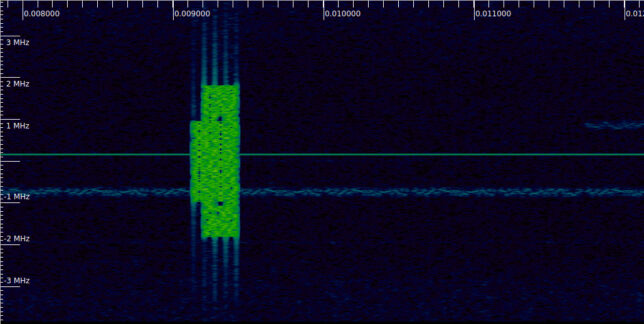This is a short note about the losses caused by non-matched pulse filtering in the demodulation of a PAM waveform. Recently I’ve needed to come back to these calculations several times, and I’ve found that even though the calculations are simple, sometimes I make silly mistakes on my first try. This post will serve me as a reference in the future to save some time. I have also been slightly surprised when I noticed that if we have two pulse shapes, let’s call them A and B, the losses of demodulating waveform A using pulse shape B are the same as the losses of demodulating waveform B using pulse shape A. I wanted to understand better why this happens.
Recall that if \(p(t)\) denotes the pulse shape of a PAM waveform and \(h(t)\) is a filter function, then in AWGN the SNR at the output of the demodulator is equal to the input SNR (with an appropriate normalization factor) times the factor\[\begin{equation}\tag{1}\frac{\left|\int_{-\infty}^{+\infty} p(t) \overline{h(t)}\, dt\right|^2}{\int_{-\infty}^{+\infty} |h(t)|^2\, dt}.\end{equation}\]This factor describes the losses caused by filtering. As a consequence of the Cauchy-Schwarz inequality, we see that the output SNR is maximized when a matched filter \(h = p\) is used.
To derive this expression, we assume that we receive the waveform\[y(t) = ap(t) + n(t)\]with \(a \in \mathbb{C}\) and \(n(t)\) a circularly symmetric stationary Gaussian process with covariance \(\mathbb{E}[n(t)\overline{n(s)}] = \delta(t-s)\). The demodulator output is\[T(y) = \int_{-\infty}^{+\infty} y(t) \overline{h(t)}\, dt.\]The output SNR is defined as \(|\mathbb{E}[T(y)]|^2/V(T(y))\). Since \(\mathbb{E}[n(t)] = 0\) due to the circular symmetry, we have\[\mathbb{E}[T(y)] = a\int_{-\infty}^{+\infty} p(t)\overline{h(t)}\,dt.\]Additionally,\[\begin{split}V(T(y)) &= \mathbb{E}[|T(y) – \mathbb{E}[T(y)]|^2] = \mathbb{E}\left[\left|\int_{-\infty}^{+\infty} n(t)\overline{h(t)}\,dt\right|^2\right] \\ &= \mathbb{E}\left[\int_{-\infty}^{+\infty}\int_{-\infty}^{+\infty} n(t)\overline{n(s)}\overline{h(t)}h(s)\,dtds\right] \\ &= \int_{-\infty}^{+\infty}\int_{-\infty}^{+\infty} \mathbb{E}\left[n(t)\overline{n(s)}\right]\overline{h(t)}h(s)\,dtds \\ &= \int_{-\infty}^{+\infty} |h(t)|^2\, dt. \end{split}\]Therefore, we see that the output SNR equals\[\frac{|a|^2\left|\int_{-\infty}^{+\infty} p(t) \overline{h(t)}\, dt\right|^2}{\int_{-\infty}^{+\infty} |h(t)|^2 dt.}.\]
The losses caused by using a non-matched filter \(h\), in comparison to using a matched filter, can be computed as the quotient of the quantity (1) divided by the same quantity where \(h\) is replaced by \(p\). This gives\[\frac{\frac{\left|\int_{-\infty}^{+\infty} p(t) \overline{h(t)}\, dt\right|^2}{\int_{-\infty}^{+\infty} |h(t)|^2\, dt}}{\frac{\left|\int_{-\infty}^{+\infty} |p(t)|^2\, dt\right|^2}{\int_{-\infty}^{+\infty} |p(t)|^2\, dt}}=\frac{\left|\int_{-\infty}^{+\infty} p(t) \overline{h(t)}\, dt\right|^2}{\int_{-\infty}^{+\infty} |p(t)|^2\, dt\cdot \int_{-\infty}^{+\infty} |h(t)|^2\, dt}.\]
We notice that this expression is symmetric in \(p\) and \(h\), in the sense that if we interchange \(p\) and \(h\) we obtain the same quantity. This shows that, as I mentioned above, the losses obtained when filtering waveform A with pulse B coincide with the losses obtained when filtering waveform B with pulse A. This is a clear consequence of these calculations, but I haven’t found a way to understand this more intuitively. We can say that the losses are equal to the cosine squared of the angle between the pulse shape vectors in \(L^2(\mathbb{R})\). This remark makes the symmetry clear, but I’m not sure if I’m satisfied by this as an intuitive explanation.
As an example, let us compute the losses caused by receiving a square pulse shape, defined by \(p(t) = 1\) for \(0 \leq t \leq \pi\) and \(p(t) = 0\) elsewhere, with a half-sine pulse shape filter, defined by \(h(t) = \sin t\) for \(0 \leq t \leq \pi\) and \(h(t) = 0\) elsewhere. This case shows up in many different situations. We can compute the losses as indicated above, obtaining\[\frac{\left(\int_0^\pi \sin t \, dt\right)^2}{\int_0^\pi \sin^2t\,dt\cdot \int_0^\pi dt} = \frac{2^2}{\frac{\pi}{2}\cdot\pi}= \frac{8}{\pi^2}\approx -0.91\,\mathrm{dB}.\]
